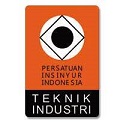Efficiency Improvement in Raw Material Inventory Management Using EOQ and POQ (Study Case: PT. Varia Usaha Beton)
Abstract
This study aims to calculate the need for inventory and ordering of raw materials for concrete production at PT. Varia Usaha Beton optimally so that there is no excess or shortage of inventory to minimize total costs using the EOQ and POQ methods, and comparing the EOQ and POQ methods that will be applied. This study is a descriptive study with a quantitative approach. Data collection is carried out using observation and interview techniques. The results of this study show that by the EOQ method, the quantity of cement raw material orders is 3,109.01 tons with an ordering period of 3 times per year and a total inventory cost of Rp124,110,362.54. Then, in the POQ method, the quantity of cement raw material orders is 708.12 tons with an ordering frequency of 12 times in one year, with an annual inventory cost of Rp368,875,317.77. With the EOQ method, the quantity of raw materials ordered for sand is 9,630.01 tons with an ordering period of 3 times per year and a total inventory cost of Rp 126,473,726.00. Then, in the POQ method, the quantity of raw materials ordered for sand is 2,515.78 tons, with an ordering frequency of 12 times in one year, with an annual inventory cost of Rp 368,875,317.77. With the EOQ method, the quantity of raw materials ordered for stone is 8,383.57 tons with an ordering period of 3 times per year and a total inventory cost of Rp 111,871,065.21. Then, in the POQ method, the quantity of raw materials ordered for stone is 2,429.67 tons, with an ordering frequency of 12 times in one year, with an annual inventory cost of Rp 242,855,765.96. Thus, using the EOQ method produces a lower total cost than the POQ method, by implementing the EOQ method in managing raw material inventory at PT. Varia Usaha Beton in 2023 is projected to save 80.5% of the previous costs on cement raw materials, 80.8% on sand raw materials, and 81% on stone raw materials.
Keywords: Inventory Control, Inventory, Economic Order Quantity, Periodic Order Quantity
Full Text:
PDFReferences
R. Ambarwati and P. P.Rumah, Manajemen Operasional dan Implementasi dalam Industri. Penerbit Pustaka Rumah C1nta, 2021.
A. L.Andries, “Analisis Persediaan Bahan Baku Kedelai Pada Pabrik Tahu Nur Cahaya Di Batu Kota Dengan Metode Economic Order Quantity (EOQ),” J. EMBA J. Ris. Ekon. Manajemen, Bisnis Dan Akunt., vol. 7, no. 2, 2019.
S.Aprilyanti, T.Tamalika, andD. A.Daliilah, “Pengendalian Persediaan Gula Aren Menggunakan Metode Economic Order Quantity, Period Order Quantity Dan Forecasting Pada Pabrik Kecap Cap Bulan,” Ind. Inov. J. Tek. Ind., vol. 14, no. 2, pp. 177–182, 2024.
Assauri, Manajemen Operasi Produksi (Pencapaian Sasaran. Organisasi Berkesinambungan)., vol. 3. 2017.
R. Fitriana and L.Zanah, “Pengaruh Pengendalian Internal Persediaan Bahan Baku Dan Perencanaan Proses Produksi Terhadap Kelancaran Proses Produksi Pada PT. Daliatex Kusuma,” Akurat| J. Ilm. Akunt. FE UNIBBA, vol. 11, no. 3, pp. 93–114, 2020.
M.Rahaman, “Solution Strategy for Fuzzy Fractional Order Linear Homogeneous Differential Equation by Caputo-H Differentiability and Its Application in Fuzzy EOQ Model,” Studies in Fuzziness and Soft Computing, vol. 412, pp. 143–157, 2022. doi: 10.1007/978-3-030-73711-5_5.
O. A. Alamri, “An EOQ Model with Carbon Emissions and Inflation for Deteriorating Imperfect Quality Items under Learning Effect,” Sustain., vol. 14, no. 3, 2022, doi: 10.3390/su14031365.
S. Maity, “A study of an EOQ model of green items with the effect of carbon emission under pentagonal intuitionistic dense fuzzy environment,” Soft Comput., vol. 27, no. 20, pp. 15033–15055, 2023, doi: 10.1007/s00500-023-08636-5.
M.Kumari, “An EOQ model for deteriorating items analyzing retailer’s optimal strategy under trade credit and return policy with nonlinear demand and resalable returns,” Int. J. Optim. Control Theory. Appl., vol. 12, no. 1, pp. 47–55, 2022, doi: 10.11121/ijocta.2022.1025.
A. Fallahi, “A constrained multi-item EOQ inventory model for reusable items: Reinforcement learning-based differential evolution and particle swarm optimization,” Expert Syst. Appl., vol. 207, 2022, doi: 10.1016/j.eswa.2022.118018.
L. C.Wu, “Formulated Optimal Solution for EOQ Model with Fuzzy Demand,” IAENG Int. J. Comput. Sci., vol. 50, no. 3, 2023, [Online]. Available: https://api.elsevier.com/content/abstract/scopus_id/85170256455
P. K.Ghosh, “An EOQ model with backordering for perishable items under multiple advanced and delayed payments policies,” J. Manag. Anal., vol. 9, no. 3, pp. 403–434, 2022, doi: 10.1080/23270012.2021.1882348.
J. T.Thomas, “Design of Fuzzy Economic Order Quantity (EOQ) Model in the Presence of Inspection Errors in Single Sampling Plans,” J. Reliab. Stat. Stud., vol. 15, no. 1, pp. 211–228, 2022, doi: 10.13052/jrss0974-8024.1519.
R. Sundararajan, “Price determination of a non-instantaneous deteriorating EOQ model with shortage and inflation under delay in payment,” Int. J. Syst. Sci. Oper. Logist., vol. 9, no. 3, pp. 384–404, 2022, doi: 10.1080/23302674.2021.1905908.
F. W.Harris, “How many parts to make at once,” Oper. Res., vol. 38, no. 6, pp. 947–950, 1990.
X.Shi et al., “Application of Quality Control Circle in the Management of Drug Repercussion in Outpatient Pharmacy of Our Hospital,” China Pharm., pp. 25–28, 2018.
P.Kotler, K. L.Keller, M.Brady, M.Goodman, and T.Hansen, Marketing Management, 3rd edn, PDF eBook. Pearson Higher Ed, 2016.
S. Chopra and P.Meindl, Supply Chain Management: Strategy, Planning, and Operation. 2016.
L. Lee and J.Kim, “Development of priority index for intelligent vessel traffic monitoring system in vessel traffic service areas,” Appl. Sci., vol. 12, no. 8, p. 3807, 2022.
K.Sallam, A. W. Mohamed, and M. Mohamed, “Internet of Things (IoT) in Supply Chain Management: Challenges, Opportunities, and Best Practices,” Sustain. Mach. Intell. J., vol. 2, pp. 1–32, 2023, doi: 10.61185/smij.2023.22103.
A. Fallahi, “A sustainable production-inventory model joint with preventive maintenance and multiple shipments for imperfect quality items,” Sci. Iran, vol. 30, no. 3, pp. 1204–1223, 2023, doi: 10.24200/sci.2021.55927.4475.
H. C. Ho, “Customer-centric approach to determine key drivers of sales growth and appropriate inventory management,” Proceedings of the International Conference on Industrial Engineering and Operations Management. 2020. [Online]. Available: https://api.elsevier.com/content/abstract/scopus_id/85096621714
N.Martin, “Eco-conscious customer centric inventory model with fractional order approach,” Adv. Math. Sci. J., vol. 9, no. 4, pp. 1773–1786, 2020, doi: 10.37418/amsj. 9.4.33.
Z.Guo, “Implications on managing inventory systems for products with stock-dependent demand and nonlinear holding cost via the adaptive EOQ policy,” Comput. Oper. Res., vol. 150, 2023, doi: 10.1016/j.cor.2022.106080.
J. X.Zhang, “Joint optimization of preventive maintenance and inventory management for standby systems with hybrid-deteriorating spare parts,” Reliab. Eng. Syst. Saf., vol. 214, 2021, doi: 10.1016/j.ress.2021.107686.
R. Miriam, “Decision Making On Consistent Customer Centric Inventory Model With Quality Sustenance And Smart Warehouse Management Cost Parameters,” Decis. Mak. Appl. Manag. Eng., vol. 6, no. 2, pp. 341–371, 2023, doi: 10.31181/dmame622023649.
DOI: http://dx.doi.org/10.24014/jti.v11i1.35903
Refbacks
- There are currently no refbacks.
Copyright (c) 2025 Tsania Lutfia Salsabila Ali Tamam, Fourry Handoko, Sony Haryanto

This work is licensed under a Creative Commons Attribution-NonCommercial-ShareAlike 4.0 International License.
Jurnal Teknik Industri
P-ISSN 2460-898X | E-ISSN 2714-6235
Published by:
Industrial Engineering Department
Universitas Islam Negeri Sultan Syarif Kasim Riau, Indonesia
Office Address:
H.R. Soebrantas KM 15.5, Tampan, Pekanbaru, Riau, Indonesia 28293
email: jti.fst@uin-suska.ac.id
Indexed by:
JTI : Jurnal Teknik Industri under a Creative Commons Attribution-NonCommercial-ShareAlike 4.0 International License.

















